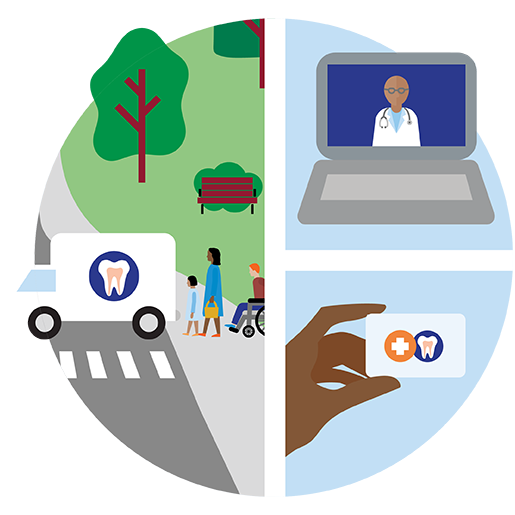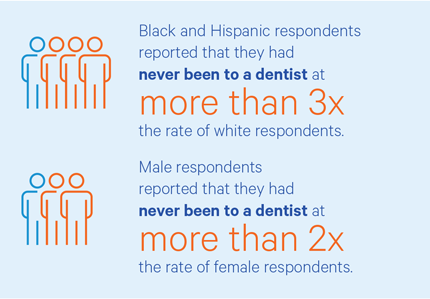Enter your email to receive the CareQuest newsletter:
Access to Care
Oral health care is challenging for many Americans to access. Lack of insurance is one key barrier. Others include a shortage of nearby providers, transportation issues, and cultural and emotional hurdles. Without expanding access, we will never realize a future where equitable systems promote better health, allowing every person to reach their full potential.

Obstacles (and Costs) to Access
An estimated 68.5 million American adults do not have dental insurance. In addition, more than 56 million Americans live in areas with a shortage of dental professionals. For many Americans, inadequate transportation and lack of job flexibility impede their ability to schedule regular dentist appointments.
When people don’t receive dental care, both oral health and overall health can easily deteriorate. According to ADA research, a lack of access to care can lead to untreated tooth decay or other infections, leaving people with no viable options other than visiting hospital EDs, where treatment is costly and can disrupt more urgent needs in a time of crisis.
The good news is that promising solutions to expand access are available — and some of them have already started to prove their value.
Who needs access to oral care?
Medicare Recipients
As of 2021, more than 26 million Medicare recipients lack dental coverage. There was momentum behind adding dental to Medicare in the fall of 2021, but the social spending proposal was trimmed, keeping the benefit out of the program for now.

View visual report
Medicaid Recipients
As of 2021, 8.5 million Medicaid recipients lack dental coverage. Within Medicaid, comprehensive dental coverage is mandatory for children, but dental benefits for Medicaid-eligible adults are optional. And states have flexibility in how they interpret “benefits,” often looking at them for potential cuts when budgets get tight, resulting in coverage that varies tremendously across states.
To better understand the landscape, CareQuest Institute, working with other leading oral health organizations, created the Medicaid Adult Dental Coverage Checker. The Checker is an interactive tool for policymakers, administrators, and advocates to easily understand where a given state’s Medicaid adult dental benefits package falls on a continuum from no dental benefits to extensive benefits, helping them identify areas for improvement and expansion.
Communities of Color
According to recent CareQuest Institute research:
- Black adults are 68% more likely to have an unmet dental need than white adults.
- Latino adults are 52% more likely than white adults to report having difficulty doing their job due to poor oral health.
- Black and Hispanic respondents reported that they had never been to a dentist at more than 3x the rate of white respondents.

Underserved Populations
According to CareQuest Institute and American Institute of Dental Public Health (AIDPH) research, compared to non-veterans, veterans have consistently higher rates of periodontitis, missing teeth, and filled teeth, even when controlling for other factors like chronic medical conditions and smoking status. Veterans are also more likely to have health conditions such as diabetes and hypertension that are associated with poor oral health and often lead to higher out-of-pocket costs for patients.

Prioritizing Underserved Populations
It’s essential to ensure that underserved populations are not forgotten. In addition to poorer communities and communities of color, veterans also lack the oral health coverage and access they need and deserve.
Roughly 19 million veterans live in the US, comprising about 6% of the total population. Those veterans are more likely to experience worse oral health outcomes — higher rates of tooth decay, higher rates of gum disease, and an increased need for restorative dental care — compared to nonveterans.

2M
56M
1M
2.5X

Paths to Expanding Access
One important part of the solution is to expand insurance coverage, for example, by strengthening and protecting adult dental benefits within Medicaid and Medicare. One recent study showed that Medicaid, even with its limited dental coverage, significantly improved adults’ access to and utilization of dental services, compared to those who lack medical coverage. The Medicaid Adult Dental Coverage Checker, released in the summer of 2022, will give policymakers, administrators, and advocates more knowledge about each state's benefits package, helping them identify areas for improvement and expansion.
Teledentistry — care delivered virtually through various mechanisms — offers several avenues to increased access. In one recent study, patients have reported overwhelmingly positive responses to their teledentistry experience, with 86% saying they would recommend teledentistry to another person.
Reaching patients in nontraditional settings such as schools, nursing homes, and community centers can be beneficial, too. CareQuest Institute research found that nearly one million Medicaid-enrolled children nationwide already rely on schools to access basic preventive dental care.
